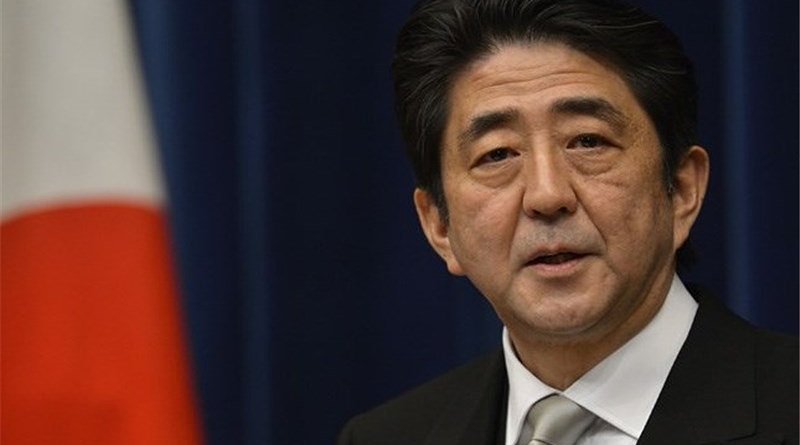Japan: The Race To Replace Shinzo Abe – Analysis
A race to replace Japan’s Prime Minister Shinzo Abe has begun. Recent political developments have weighed on his government and a consensus has emerged that a fourth term for Abe is unsustainable.
By Purnendra Jain and Takeshi Kobayashi
Japan’s general election is not due until October 2021 and Prime Minister Shinzo Abe still has over a year until his current term ends in September 2021. Abe’s Liberal Democratic Party (LDP) enjoys majorities in both houses of parliament, while the opposition remains weak and fragmented.
Yet the race to replace Abe has already begun. Recent political developments have weighed on his government and a consensus has emerged that a fourth term for Abe as LDP president is unsustainable.
The popularity of Abe’s cabinet has nosedived from over 70 per cent in 2013 to the low 30s today — the Moritomo Gakuen, Kake Gakuen, cherry blossom party and other scandals have plagued his government. Disgraced ministers have resigned but Abe has not provided satisfactory answers about his own alleged involvement in unethical practices.
Voters have been critical of Abe’s response to COVID-19, as he prioritised the economy and diplomacy over public health concerns. Abe left the announcement to postpone the 2020 Summer Olympics until late and he had hoped to demonstrate his diplomatic acumen by hosting Chinese President Xi Jinping in April. In the absence of strong leadership amid the pandemic, some scholars ascribe Japan’s comparatively low numbers of infection and death to a ‘miracle’.
Concerns about Abe’s health after his recent unexpected visits to hospital have also raised alarm bells. Notably, Abe suddenly stepped down once before in 2007 — a year into his first term as prime minister — owing to his poor health from ulcerative colitis, an inflammatory bowel disease.
Although Abe is reportedly back to work and looks safe in his position for now, LDP politicians have started to prepare for a post-Abe government. A cabinet reshuffle and changes in LDP top executives are on the cards in preparation for a changing of the guard next year.
Japan’s LDP follows a rather democratic process under which rank-and-file members and parliamentarians both vote to elect the LDP president. Due to the party’s majority in parliament, its president is soon after appointed prime minister. The LDP is by no means a unified and ideology-based party, and factions play a significant role in presidential elections and in the selection of ministers and party top executives.
In addition to securing factional support and votes among the rank and file, a party president must be seen to have enough popularity among voters in order to win national elections. Abe ticked both boxes, although in some cases, like former Japanese prime minister Junichiro Koizumi, high popularity among voters mattered more than factional support.
There are currently seven LDP factions to which most parliamentarians belong, with the exception of those who run their own small groups or prefer to remain independent. No unaffiliated LDP parliamentarian has ever been elected as president.
There are several potential candidates whose names regularly appear in the media. The most prominent of these candidates are LDP Policy Chief Fumio Kishida, former party secretary general Shigeru Ishiba, Defense Minister Taro Kono and Foreign Minister Toshimitsu Motegi.
The governors of Tokyo and Osaka also poll well because of their able leadership in dealing with COVID-19. Reports surfaced that Abe’s preferred pick for prime minister is Chief Cabinet Secretary Yoshihide Suga, but Suga has denied any interest.
There are two powerful LDP leaders whose support will be crucial in electing the next party president — Prime Minister Abe himself and LDP Secretary General Toshihiro Nikai. Abe is Japan’s longest serving prime minister and Nikai is the longest serving secretary general, the second most powerful party post after the president.
Abe comes from the largest faction, the Hosoda faction, with 98 parliamentarians. This faction has supplied all LDP prime ministers over the last two decades, beginning with Yoshiro Mori in 2000 and continuing through to Abe, with the exception of Taro Aso in 2008 who heads his own faction.
Nikai, being an octogenarian, will not contest. But his role will be critical given his influence in the party through extensive networks nationwide in his capacity as party secretary general. He also leads a faction of 47 parliamentarians who will not be endorsing their own candidate for the position.
In the most recent Mainichi Shimbun poll conducted on 22 August, Shigeru Ishiba was ranked number one, Taro Kono number two and Abe number four. These rankings show Abe’s dwindling popularity and reveal Ishiba as a front runner despite the fact that he has not held a cabinet or party post for some time. Meanwhile, Kono’s candidacy will depend on whether Aso, his faction boss, will endorse him.
Both Ishiba and Kono have unsuccessfully run for the party presidency before (Ishiba in 2008, 2012 and 2018 and Kono in 2009) and both intend to run again this time. But a clear answer to who may replace Abe does not lie with media-led indicators of popularity. The most decisive factors will be how faction members vote and the preferences of the LDP rank and file members.
As the race to replace Abe intensifies, the one thing that is clear is that Shinzo Abe has become a lame duck prime minister.
*About the authors:
- Purnendra Jain is Adjunct Professor in the Department of Asian Studies at the University of Adelaide.
- Takeshi Kobayashi holds a Master’s degree in International Relations from the American University, Cairo, and is a staffer to a House of Councillors member.
Source: This article was published by East Asia Forum

